
Water Filter Buying Guide

Home & Appliances Writer
If you’re like a majority of Americans, the water from your household tap travels through miles of aquifers, pipes, and treatment systems before landing in your glass. One of the easiest ways to boost the quality of that water is by using a home water filter, either under your sink, in your fridge, on your countertop, or attached to your faucet.
While many people buy water filters simply to improve the taste or appearance of their tap water, some filters can also protect them from harmful contaminants. Although the safety of the nation’s water supply improved markedly after the passage of the Safe Drinking Water Act in 1974, a joint Consumer Reports-Guardian US investigation of the nation’s tap water in 2021 revealed that 118 of 120 tested locations across the U.S. had detectable amounts of lead, arsenic, or PFAS (per- and polyfluoroalkyl substances) above CR’s recommended maximum levels. And CR’s research has revealed that many Americans still drink water with unhealthy levels of toxic contaminants.
The right water filter can not only protect against these contaminants but also improve the taste of your tap water. Because drinking-water complaints often relate to taste and smell, all of the filters we test, including water filter pitchers, under-sink water filters, faucet-mounted filters, and countertop filters, are judged on how well they improve taste and reduce odors.
How CR Tests Water Filters
In our lab, we check how well filters improve flavor and reduce odor by spiking spring water with commonly found compounds that can make it smell and taste like a sewage treatment plant, damp soil, metal, or a swimming pool. A panel of professional tasters then evaluates how successfully each filter removes those flavors and odors. The best-performing filters work well enough that most people wouldn’t be able to discern a palatable difference between the filtered water and pure spring water.
We also test a water filter’s flow rate by measuring how long it takes to filter one quart of water; the faster the filtering, the higher the score. We also give each filter a “clogging” score based on how much its flow rate slows down over the filter cartridge’s stated life.
NSF International (originally the National Sanitation Foundation) and the American National Standards Institute (ANSI) develop filtration standards. If a manufacturer claims that a pitcher meets NSF/ANSI standards for removing specific contaminants, such as chlorine, lead, and PFAS, we verify those claims and include that information in our ratings.
What's in Your Water?
The Environmental Protection Agency requires community water suppliers to provide customers with a Consumer Confidence Report (CCR) every July. The CCR states if any regulated contaminants are detected in the water and how they compare with the EPA’s drinking water standards.
Community water systems that serve at least 100,000 people must post CCR reports online. The EPA doesn’t regulate private wells, but well-water users can check with the Centers for Disease Control and Prevention for information on well testing and treatment.
The CCR report informs you about the quality of the water supplied by your utility. But the route it takes from the utility to your glass is important, too. If your house was built before lead-free pipes were mandated in 1986, you may want to do your own tests for lead. When purchasing a new faucet, make sure it meets U.S. safety standards for lead. Recently, the Consumer Product Safety Commission warned consumers that a number of imported faucets could leach dangerous amounts of it. (According to the EPA, there’s no safe level of lead exposure.)
Another drinking-water contaminant of concern is a class of more than 12,000 synthetic chemicals known as PFAS (per- and polyfluoroalkyl substances) that persist in the environment and have been linked to health issues that include immune system suppression, learning delays in children, thyroid disease, and some cancers. According to a 2023 study by the U.S. Geological Survey, at least 45 percent of the nation’s tap water is contaminated by PFAS. In the 2021 CR-Guardian study cited above, almost every test sample had measurable levels of PFAS, and more than 35 percent exceeded the maximum safety threshold CR scientists and other health experts specified.
The Environmental Protection Agency established the first nationwide limits for PFAS in drinking water in 2024, along with requirements that public water systems monitor six PFAS compounds and take action if levels rise above prescribed limits. In May 2025, however, the EPA reconsidered the new limits on four compounds and delayed enforcement of limits on two others until 2031. According to the environmental coalition SaferStates, 11 states (Maine, Massachusetts, Michigan, New Hampshire, New Jersey, New York, Pennsylvania, Rhode Island, Vermont, Washington, and Wisconsin) have established standards for the level of PFAS in drinking water.
If your utility doesn’t test for PFAS, or if you use well water, you can get your water tested by an EPA-certified lab like SimpleLab or WaterCheck from National Testing Laboratories.
How to Choose a Water Filter
Once you know what’s in your tap water, you can find a filter that best suits your needs.
If tests reveal no harmful contaminants and the only problem with your water is taste and/or odor, check CR’s water filter ratings for filters that score high in our flavor/odor reduction tests.
If tests reveal contaminants, look for a water filter certified to remove those substances. That means the filter has been independently tested to confirm it complies with an accepted standard specific to the contaminant and is subject to follow-up testing by the certifying agency to ensure continued compliance.
All of the under-sink water filters in CR’s ratings are certified to NSF standards for reducing lead, as well as many of the faucet-mounted filters and a few of the water filter pitchers. CR’s ratings also indicate which of the water filters we tested are certified to the NSF/ANSI (American National Standards Institute) standard for reduction of PFOA (perfluorooctanoic acid) and PFOS (perfluorooctane sulfonate), two of the most concerning PFAS. These include some water filters in each category, including water filter pitchers, under-sink water filters, and one faucet-mounted water filter.
Our ratings also indicate whether a filter is certified to reduce chlorine, which can affect taste and smell.
If you’re considering a filter that’s not in our ratings, look at the filter’s packaging for a stamp or seal confirming which contaminants it’s certified to remove. Third-party labs certifying water filters to accepted NSF/ANSI standards include the NSF, the Water Quality Association (WQA), and IAPMO. Be wary of marketing language that hypes contaminant-removal claims or features, or false certifications from unverified testing labs.
Keep in mind that filter cartridges must be replaced periodically to function effectively. Our ratings allow you to compare each product’s annual filter replacement cost. For example, replacement filters for the pitchers we test range from about $20 to $160. You’ll also see which models have a filter-life indicator, a handy feature that tells you when to change the filter.
Filtering Your Choices
While water filter pitchers are one of the most popular types of water filters, several other filtration options are available for the home. Consider your budget (including filter replacement costs) and water consumption, as well as why you want to filter your water in the first place. Is it simply to improve the taste, or are there potentially harmful substances you need to remove? The answers will help you choose the filter that’s right for your home.
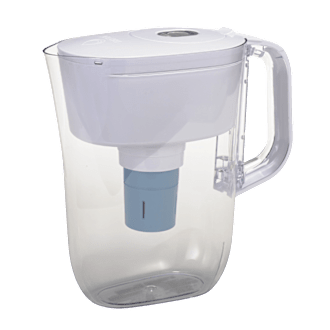
Water Filter Pitcher
Water filter pitchers, the kind you store in your fridge, feature an internal carbon cartridge that filters tap water after it’s poured into the carafe. Typically costing from $20 to $40, they’re great if you’re on a budget, you don’t have the space to install a permanent filter, or you’re renting.
Pros:
✔ Very good at removing bad tastes and odors without sacrificing cartridge life or flow rate
✔ Easy to install and easy to use
✔ Relatively low cost
Cons:
✘ Need constant refilling
✘ Some are slow, prone to clogging, or have a short cartridge life
✘ Less convenient for large families
✘ Few pitchers filter for chlorine, lead, and PFAS
Price of tested filters: $20 to $140.
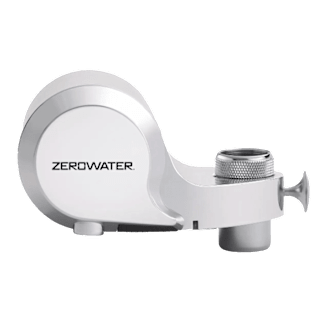
Faucet-Mounted Water Filter
Faucet-mounted water filters attach directly to your tap. Simply unscrew the aerator from the faucet’s threaded tip and screw on the filter. A lever switches between filtered and unfiltered water, so you can filter drinking and cooking water, but use unfiltered water for other tasks, such as dishwashing or watering plants. Most use granulated activated carbon cartridges that draw away contaminants before water leaves your tap. Some will remove chlorine, lead and/or PFAS (check our ratings for the ones certified to do this).
Pros:
✔ Don’t require a plumber to install
✔ Convenient for apartment dwellers
✔ Relatively inexpensive (less than $40, but replacement cartridges may be double that)
Cons:
✘ Can interfere with sink space
✘ Slow down the water flow
✘ Don’t fit on all faucets, especially pullout sprayers
Price of tested filters: $20 to $40.
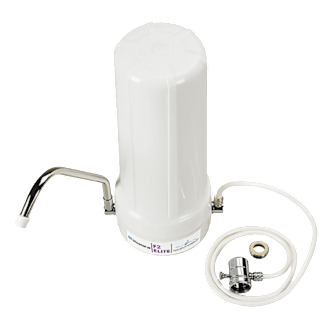
Countertop Water Filter
Countertop filters attach to your tap with a hose that diverts water through a small sink-side purifying device equipped with a spout. They’re installed by removing the threaded aerator and screwing the filter hose onto the faucet. Basic models use carbon filtration to draw away contaminants before water leaves your tap; pricier units may use reverse osmosis or ultraviolet light to guard against more serious contaminants. Replacement cartridge costs range from $85 to $145.
Pros:
✔ DIY installation
✔ Handy for renters
✔ Typically remove more contaminants than other types
✔ Some beautify your kitchen with sleek designs and technology
Cons:
✘ Replacement cartridges can cost more than the filter unit itself
✘ Units can clutter your countertop
✘ May not fit all faucets
Price of tested filters: $80 to $100.
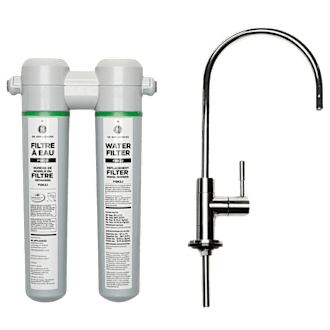
Under-Sink Water Filter
Pricey yet convenient, under-sink filters can clean a higher volume of water at a greater flow rate than other types. But beware: Replacement filters can be costly (ranging from $80 to more than $320 for the models we’ve tested). Many under-sink filters come with a dedicated faucet, requiring an additional hole to be drilled in your countertop; others connect to your existing faucet. Some under-sink models use reverse osmosis (RO) filtering, which forces water through a semipermeable membrane and removes a wider range of contaminants than carbon-filter models.
Pros:
✔ Hidden under the cabinet (no counter clutter)
✔ Can remove a wide range of contaminants (lead, VOCs, PFAS, and others) depending on the filtering system
✔ Filters lots of water without sacrificing flow rate
Cons:
✘ Expensive
✘ May require custom plumbing, sink, or countertop alterations
✘ Take up undercounter cabinet space
Price of tested filters: $86 to $700.
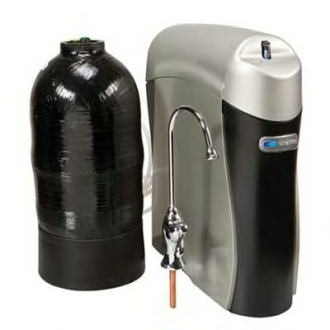
Reverse Osmosis Water Filter
If you’re facing more serious water contamination problems, you may need the more powerful filtration of a reverse osmosis system. In addition to carbon filters, reverse-osmosis units force water through a semipermeable membrane under high pressure to remove many contaminants, including dissolved solids. But they can be extremely slow to filter water, they rob cabinet space, and they typically create 3 to 5 gallons of wastewater for every gallon filtered. You must sanitize them periodically with bleach, and the membrane and filters must be replaced per the manufacturer’s recommendation. CR is expecting to publish new ratings of RO filters in late 2025.
Pros:
✔ Hidden under the cabinet (no counter clutter)
✔ Remove a wider range of contaminants than other types
Cons:
✘ Expensive
✘ Produce a large volume of wastewater
✘ May require professional installation
✘ Take up cabinet space
✘ Require maintenance
Price of typical filter: $200 to $2,200.
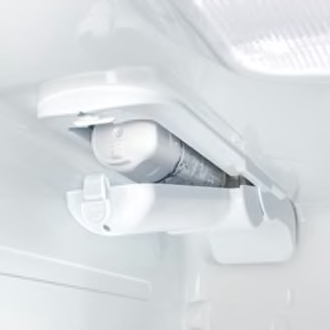
Refrigerator Water Filters
Water-and-ice dispensers are common on French door, bottom-freezer, and side-by-side refrigerators. The water line typically runs through a filter inside the refrigerator. Most filters can be easily replaced by simply pushing and twisting to remove. A replacement filter can cost $50 or more, and you’ll need to change it every six months or so. Third-party water filters are widely available at a lower cost, but they may be less reliable or effective. Depending on the particular filter, fridge filters can reduce many of the same contaminants as a countertop or under-sink filter.
Pros:
✔ Automatically provide chilled, filtered water
✔ Don’t require countertop alterations
Cons:
✘ Refrigerators with built-in filters tend to be expensive
✘ Not available on all refrigerator models
✘ May remove a limited number of contaminants
✘ Water filter/icemakers are prone to malfunctions
Consumer Reports is currently testing refrigerator water filters with results expected in late 2025.
Water Filter Brands
Aarke is a Swedish company that specializes in premium kitchen appliances that combine aesthetics, functionality, durability, and sustainability.
Apex Water Filters is a family-owned, California-based company that manufactures and distributes residential and commercial water filters, including countertop, under-sink, reverse osmosis, whole-house systems, and ultraviolet disinfection systems.
Aqua-Pure is a 3M company that sells a variety of water treatment systems and products, including under-sink, reverse osmosis, whole-house, faucet filters, and replacement filters. It also offers water softeners. Aqua-Pure filters are sold at Amazon, Home Depot, Lowe’s, and other retailers.
Aquasana’s countertop models use a dual filtration system that has an ion exchange method in the water filtration process. Its products are sold online, at large retailers like Home Depot and Lowe’s, and at plumbing supply outlets.
This Clorox-owned brand dominates the pitcher category and also offers faucet-mounted models. Brita water filters are sold at national chains such as Home Depot, Lowe’s, Sears, Target, and Walmart, and at hardware and plumbing supply stores, drugstores, and online retailers.
Brondell offers a variety of three-stage countertop, under-counter, and reverse osmosis filtration systems as well as water filter faucets and replacement filters. They’re sold online at Amazon, Wayfair, and on the company’s website.
Crystal Quest offers a selection of water treatment solutions, including pitchers, countertop, faucet-mounted, under-sink, reverse osmosis, and whole-house water filter systems.
This company offers a wide range of products, including both single-stage and multistage filters. Culligan filters are sold through many major retailers, such as Home Depot, Walmart, and Ace Hardware, as well as through independent dealers nationwide and online.
Pentair’s Everpure produces whole-house, under-sink, countertop, reverse osmosis, and shower water filters, replacement filters, and water softeners. Its 1-stage, 2-stage, and 3-stage water filters can be found on its website and at plumbing supply stores.
Home Master water filters are made by Perfect Water Technologies, which specializes in residential reverse osmosis and whole-house water purification systems. They’re sold at Amazon, Home Depot, and ThePerfectWater.com.
Kräus is a manufacturer of high-design, functional, and sustainable kitchen and bathroom sinks, faucets, and accessories. Many of its products offer stylish, space-saving, or sustainable solutions, like water filters crafted from reclaimed plastics. They’re sold at major retailers like Walmart, Amazon, Lowe’s, and AJ Madison.
Multipure, the original developer of the solid block carbon filter, makes a variety of residential and commercial filters that it claims remove a broad range of harmful contaminants such as lead, mercury, arsenic, chlorine, asbestos, and PFOA.
This manufacturer offers a wide range of water filter products, such as faucet-mounted filters, filter pitchers, and large-capacity dispensers. (CR doesn’t currently test the latter.) Pur filters are available at national chains such as Home Depot, Lowe’s, Sears, Target, and Walmart, and at hardware and plumbing supply stores, drugstores, and online retailers.
Soma filters are sustainably made from 60 percent plant-based and renewable materials for a lower carbon footprint. The company says its products filter out chlorine, mercury, zinc, cadmium, copper, and other unwanted tastes and odors through activated coconut shell carbon and charcoal. Soma filters are sold through Crate & Barrel, The Container Store, and directly from the manufacturer.
This brand includes filter pitchers and faucet-mounted filters. They use a multistage filtration process and are sold at most big-box stores, such as Target, Best Buy, and Home Depot.



























